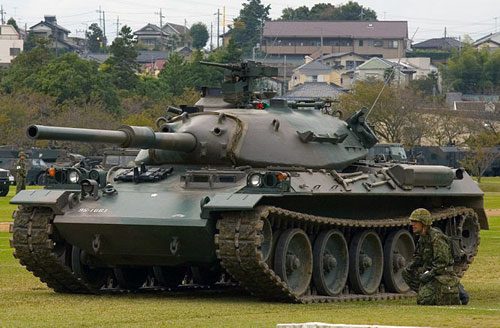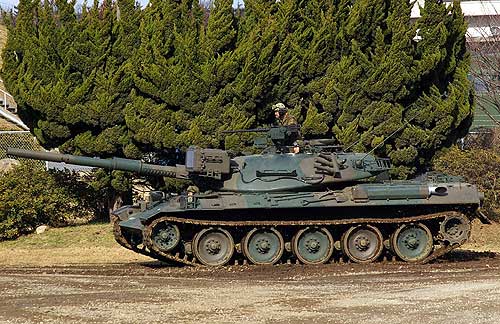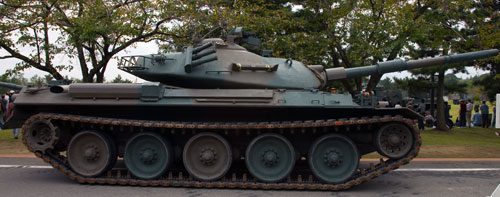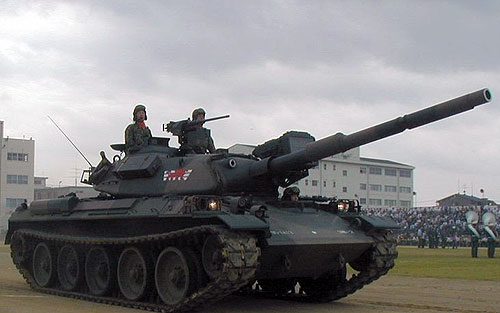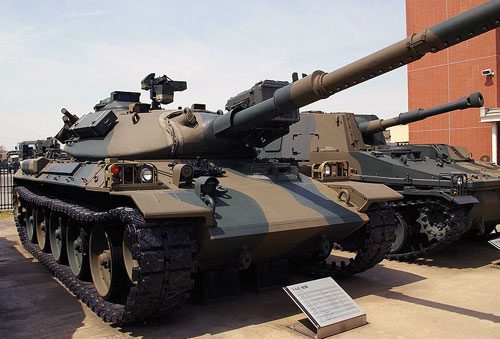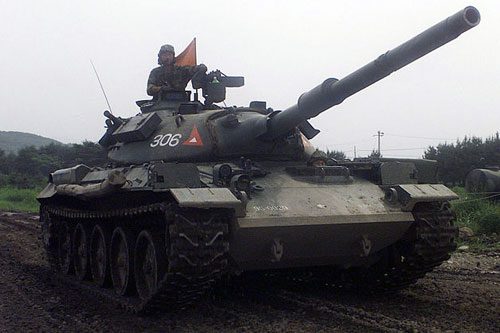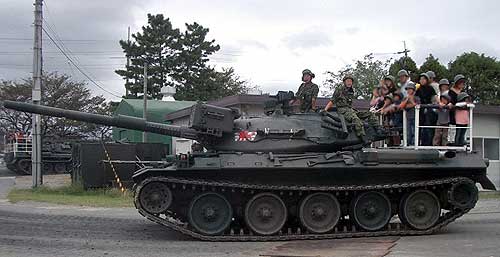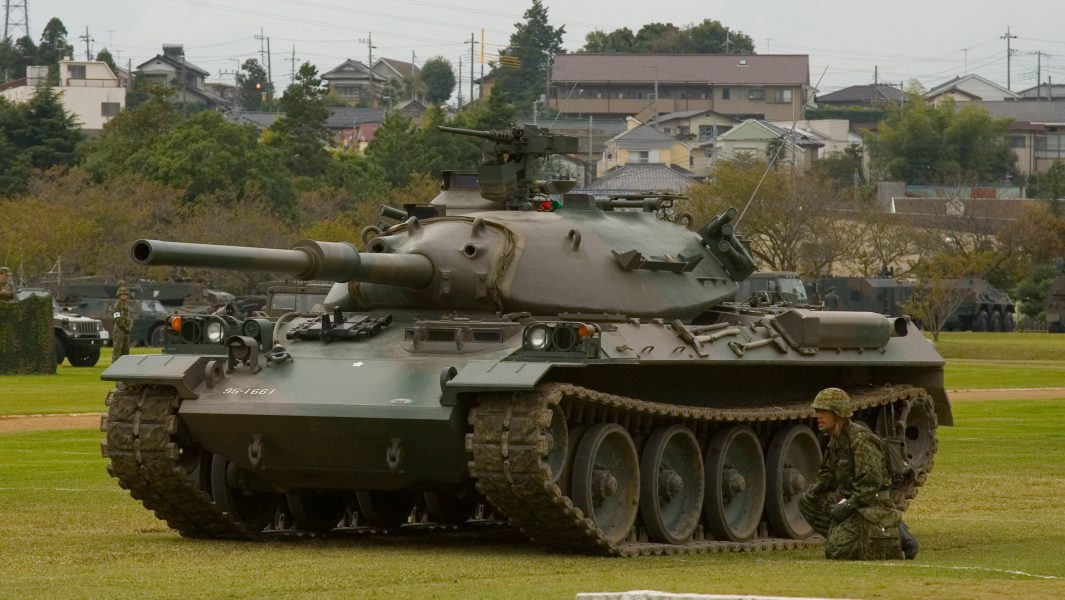
Main battle tank Type 74
Main battle tank Type 74
The main tank "74" has a classic layout with a stern engine and transmission. Its hull is welded from armor plates, the turret is cast. Ballistic protection is improved by the use of a streamlined turret and high angles of inclination of the upper armor plates of the hull. The maximum armor thickness of the frontal part of the hull is 110 mm at an angle of inclination of 65°. The main armament of the tank is a 105-mm English rifled gun L7A1, stabilized in two guidance planes. It is manufactured under license by Nippon Seikose. The recoil devices have been upgraded. It can fire 105-mm ammunition used in the armies of NATO countries, including the American armor-piercing M735 sub-caliber projectile, produced in Japan under license.
The ammunition load of the “74” tank includes only armor-piercing sub-caliber and armor-piercing high-explosive shells, a total of 55 rounds, which are placed in the niche of the rear of the tower. Loading is manual. Vertical gun pointing angles from -6° to +9°. Due to the hydropneumatic suspension, they can be increased and range from -12° to +15°. The auxiliary armament of the “74” tank includes a 7,62-mm coaxial machine gun located to the left of the cannon (4500 rounds of ammunition). A 12,7-mm anti-aircraft machine gun is openly mounted on a bracket on the turret between the hatches of the commander and the loader. It can be fired by both the loader and the commander. The vertical aiming angles of the machine gun are in the range from -10° to +60°. Ammunition - 660 rounds.
On the sides of the aft part of the tower, three grenade launchers are mounted for setting smoke screens. The fire control system includes a laser sight-rangefinder, the main and additional sights of the gunner, the weapon stabilizer, an electronic ballistic computer, the commander's and gunner's control panels, as well as the guidance drives for measuring the range and preparing data for firing are assigned to the commander. He uses a combined (day / night) periscopic sight, which has a built-in ruby laser rangefinder that measures a range from 300 to 4000 m. The sight has an 8x magnification and is connected to the cannon using a parallelogram device. For all-round visibility, there are five periscopic viewing devices installed along the perimeter of the commander's hatch. The gunner has a main combined (day / night) periscopic sight with 8x magnification and an auxiliary telescopic sight, active-type night vision devices. The target is illuminated by a xenon searchlight installed to the left of the gun mask.
A digital electronic ballistic computer is installed between the commander and the gunner, with the help of which, by means of input information sensors (ammunition type, powder charge temperature, barrel bore wear, pivot axis tilt angle, wind speed), corrections for gun aiming angles are introduced into the commander and gunner's sights. The data on the distance to the target from the laser rangefinder are entered into the computer automatically. The two-plane weapon stabilizer has electromechanical drives. Aiming and firing from a cannon and a coaxial machine gun can be carried out by both the gunner and the commander using similar control panels. The gunner, in addition, is equipped with redundant manual drives for vertical aiming and turret rotation.
The loader has a 360 ° rotating periscope observation device installed in front of its hatch. The driver is located in the control compartment in the front left part of the hull. It has three periscopic viewing devices. The Japanese specialists paid much attention to increasing the mobility of the tank, given that in many regions of Japan there are difficult-to-pass areas (muddy rice fields, mountains, etc.). Country roads are narrow, bridges on them are of low carrying capacity. All this limited the mass of the tank, which is 38 tons. The tank has a relatively low silhouette - its height is only 2,25 m. This was achieved through the use of a hydropneumatic type suspension, which allows you to change the ground clearance of the vehicle from 200 mm to 650 mm, as well as tilt the tank to the right or left board both completely and partially, depending on the terrain.
The inclination of the machine is provided by adjusting the four hydropneumatic suspension units located on the first and fifth road wheels of each side. The undercarriage does not have supporting rollers. The total travel of the track roller is 450 mm. The tension of the caterpillars can be carried out by the driver from his place with the help of a hydraulic drive of the tensioning mechanism. The tank uses two types of tracks (width 550 mm) with a rubber-metal hinge: training tracks with rubberized tracks and combat all-metal tracks with reinforced lugs. The engine and transmission of the tank are made in one block.
A two-stroke V-shaped 10-cylinder multi-fuel diesel engine 10 2P 22 WТ air-cooled was used as a power plant. It is equipped with two turbochargers connected by gears to the crankshaft. Compressor drive combined (mechanical from the engine and using exhaust gases). This significantly improves the throttle response of the two-stroke engine. Two axial fans of the cooling system are located horizontally between the cylinder blocks. At the maximum speed (2200 rpm), 120 hp are consumed to drive both fans. sec., which reduces the engine power from 870 to 750 liters. with. Dry engine weight 2200 kg. In addition to conventional diesel fuel, it can run on gasoline and aviation kerosene.
Fuel consumption is 140 liters per 100 km. The MT75A hydromechanical transmission of the Mitsubishi Cross-Drive type provides six forward gears and one reverse gear without depressing the clutch pedal, which is used only when starting off and stopping the tank. Tank "74" is equipped with a system of protection against weapons of mass destruction. It can overcome water obstacles up to 4 m deep with the help of underwater driving equipment. The production of Type 74 tanks ended at the end of 1988. By that time, the ground forces received 873 such vehicles. On the basis of the “74” tank, a 155-mm self-propelled howitzer Type 75 (outwardly resembling the American M109 howitzer), a bridge layer and an armored repair and recovery vehicle Type 78, the characteristics of which correspond to the German Standard BREM, were created. Tank Type 74 to other countries not supplied and participation in hostilities not accepted.
The performance characteristics of the main battle tank Type 74
Sources:
| ||||||||||||||||||||||||||||||||||||||||||


 In 1962, Mitsubishi Heavy Industries began developing a main battle tank. The following requirements were put forward before the creators of the new tank: to increase its firepower, to increase its security and mobility. After seven years of work, the company built the first two prototypes, which received the designation 8TV-1. They tested such solutions as mechanized loading of the gun, installation of an auxiliary engine, control of an anti-aircraft machine gun from inside the tank, and stabilization of weapons. At that time, these were quite bold and rarely seen in practice decisions. Unfortunately, some of them had to be abandoned during mass production. In 1971, the prototype 8TV-3 was built, in which there was no mechanized gun loading system. The last prototype, designated 8TV-6, was introduced in 1973. At the same time, it was decided to start mass production of a new machine, which finally became known as Type 74.
In 1962, Mitsubishi Heavy Industries began developing a main battle tank. The following requirements were put forward before the creators of the new tank: to increase its firepower, to increase its security and mobility. After seven years of work, the company built the first two prototypes, which received the designation 8TV-1. They tested such solutions as mechanized loading of the gun, installation of an auxiliary engine, control of an anti-aircraft machine gun from inside the tank, and stabilization of weapons. At that time, these were quite bold and rarely seen in practice decisions. Unfortunately, some of them had to be abandoned during mass production. In 1971, the prototype 8TV-3 was built, in which there was no mechanized gun loading system. The last prototype, designated 8TV-6, was introduced in 1973. At the same time, it was decided to start mass production of a new machine, which finally became known as Type 74.